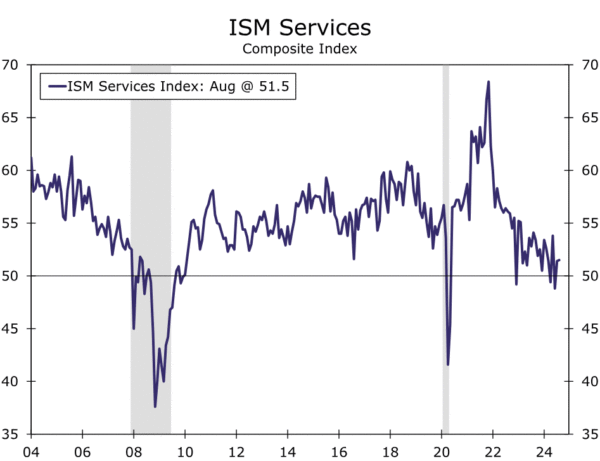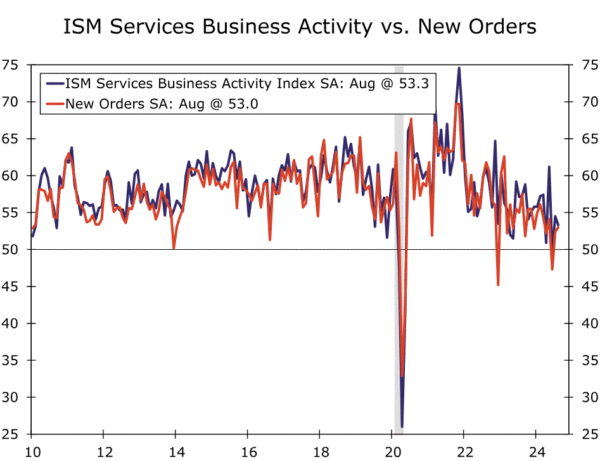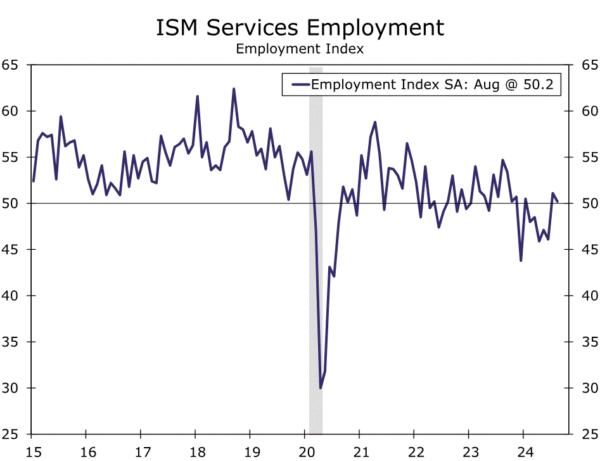Summary
The services ISM notched a modest gain in August, quelling for now concerns about stalling growth. While the prices paid measure rose, the employment measure indicates a jobs market that is in a decidedly lower gear than it was as recently as earlier this year.
ISM Rises to Three-Month High
A run of lousy jobs market data has put the once all-but-assured soft landing in doubt, and while the services sector is not immune to the soft labor signals, activity there remains in good shape. In fact, it’s improving. The ISM services index rose modestly to 51.5 in August, and while service-providers also face their fair share of challenges today, activity in the sector is merely moderating rather than declining as it is in wide swaths of manufacturing. That is giving way to a degree of measured…dare we say? optimism. (chart).
The select industry comments from purchasing manager respondents included mention of business being stable, good, strong or improving. Some others referenced high borrowing costs and elevated costs weighing on business activity, but the report remains consistent with an expanding sector, which quells some fear of stalling growth, for now.
Demand remains strong for services as new orders rose to 53.0 and eight industries reported an increase in orders in August (chart). Even as the measure of current conditions (business activity) pulled back in August, it remains consistent with expansion at 53.3 and only four of 18 industries reported a decline in activity last month.
For those parsing through the release on clarity of the jobs market, well it remains fuzzy. Sentiment was mixed as hiring continues in some industries while there are freezes in others.
It was the release of the July jobs report that sent financial markets into a tailspin just a few weeks ago. As the market awaits tomorrow’s full jobs report for August, the employment component of the ISM services index declined to 50.2 (chart). That means essentially, in aggregate, job growth is flat. Layoffs and attrition are roughly matching new-hires. In reality, the details are more mixed. Some respondents mentioned hiring declines to control costs, while others mention it’s hard to find talent even at a time when fewer jobs are available. This is not inconsistent with the separately reported slump in job openings reported yesterday.
Tomorrow’s report is key in determining by how much the FOMC will slash rates at its upcoming policy meeting on September 18. We forecast a partial rebound in August hiring and reversal of the unemployment rate from July’s increase. But if tomorrow’s job report were to come in weaker than in July, a 50 bps reduction in the federal funds rate would remain the base case.
Inflation is still on the mind of policymakers, even if the labor market has garnered more attention. We’ll get the consumer price index report next week for August, but the ISM services prices paid metric reported today rose in August to a three-month high of 57.3. That may not be problematic for policymakers. For many services companies the biggest cost is labor, so the cooling in the labor market may lead to continued improvement in service prices, a key indicator for the Fed in this cycle.
















